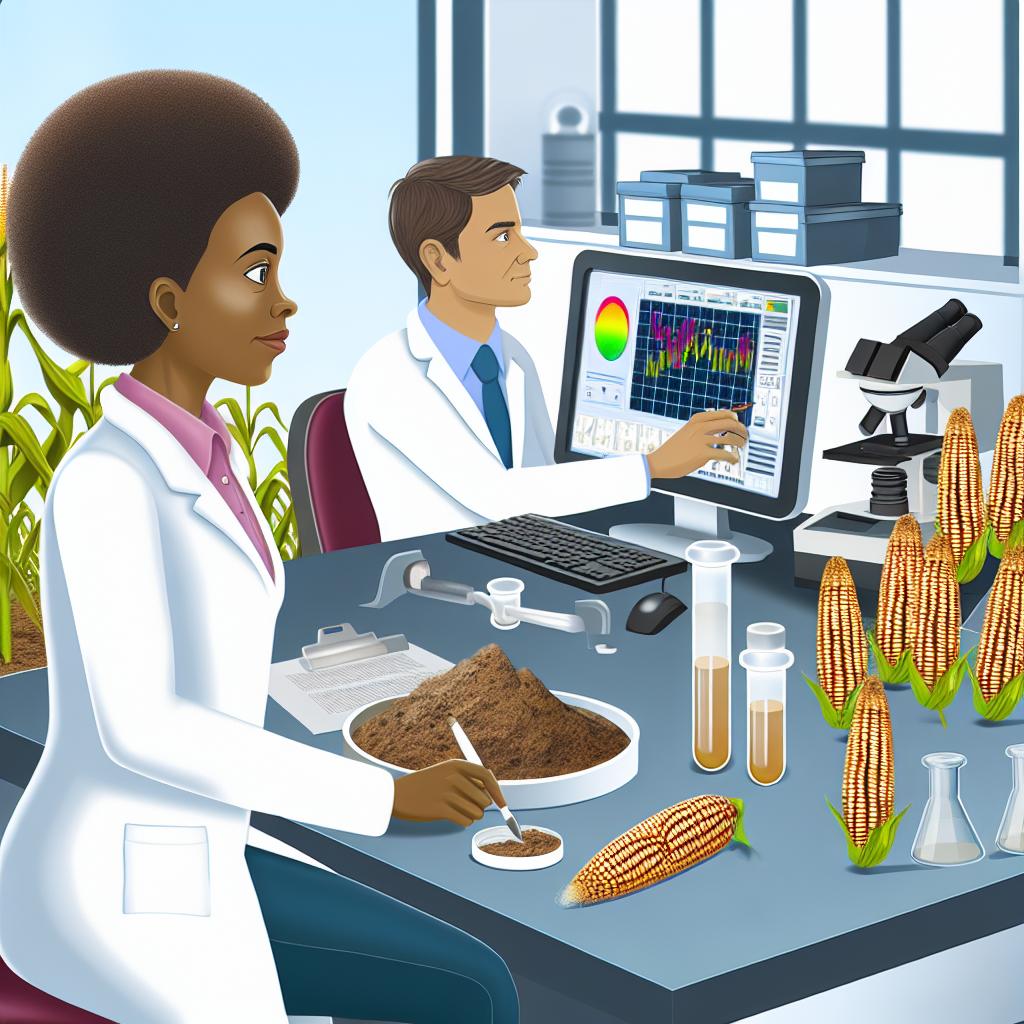Introduction
Collaborative efforts in agricultural and environmental science involve researchers working together towards common goals.
The importance of collaboration in these fields cannot be overstated.
This collaboration allows for the pooling of resources and expertise.
Improved Research Outcomes
By bringing together experts from different fields, collaborative efforts can lead to more comprehensive and innovative research outcomes.
Cross-disciplinary collaborations allow researchers to approach problems from multiple perspectives.
This leads to a deeper understanding of complex issues.
As a result, this can develop more effective solutions and technologies that benefit both the agricultural and environmental sectors.
Increased Funding Opportunities
Collaborative efforts can also open up new funding opportunities for researchers.
By partnering with other institutions, organizations, or industry stakeholders, researchers can access resources and funding.
This funding may not have been available to them otherwise.
Consequently, this support can help facilitate large-scale research projects.
Additionally, it can aid the development of new technologies and accelerate the implementation of innovative solutions.
Enhanced Knowledge Sharing and Dissemination
Collaborative efforts promote knowledge sharing and dissemination within the scientific community.
When researchers from different backgrounds come together to work on a project, they bring their unique expertise and insights.
This exchange of knowledge can lead to the development of new ideas, methodologies, and best practices.
Such innovations can benefit the wider scientific community and contribute to the advancement of agricultural and environmental science as a whole.
Examples of Successful Collaborative Projects
Collaborative efforts in agricultural and environmental science have proven to be instrumental in addressing complex challenges that require a multidisciplinary approach.
International Research Partnerships
- International research partnerships bring together experts from different countries to work towards a common goal.
- These collaborations facilitate the sharing of knowledge, resources, and expertise across borders.
- By pooling resources and expertise, international research partnerships can tackle global issues such as climate change and food security.
- An example of a successful international research partnership is the Consultative Group on International Agricultural Research (CGIAR).
- CGIAR brings together research organizations from around the world to address challenges related to agriculture, food security, and environmental sustainability.
Interdisciplinary Research Teams
- Interdisciplinary research teams combine expertise from various fields to tackle complex scientific problems.
- These teams bring together scientists, engineers, economists, and social scientists to provide holistic solutions.
- By breaking down disciplinary barriers, interdisciplinary research teams can address multifaceted issues in agriculture and the environment.
- An example of a successful interdisciplinary research team is a project that investigates the impact of agricultural practices on water quality.
- This team would include experts in hydrology, soil science, agronomy, and environmental economics.
Government and Industry Collaborations
- Collaborations between government agencies and industry partners can lead to innovative solutions for agricultural and environmental challenges.
- Government agencies provide funding, policy support, and regulatory oversight, while industry partners bring technological expertise and market knowledge.
- By working together, government and industry can develop sustainable agricultural practices, renewable energy solutions, and waste management strategies.
- An example of a successful government and industry collaboration is a project that aims to reduce greenhouse gas emissions from livestock production.
- This collaboration would involve government funding for research and industry implementation of new technologies and practices.
Learn More: Work-Life Balance for Dairy Scientists
Collaborative efforts in agricultural and environmental science often come with various challenges.
These challenges need to be addressed to achieve successful outcomes.
Transform Your Career Today
Unlock a personalized career strategy that drives real results. Get tailored advice and a roadmap designed just for you.
Start NowSome of the common challenges faced in collaboration include:
Communication barriers
One of the major challenges in collaborative efforts is communication barriers.
These barriers can arise due to differences in language, cultural backgrounds, or even technical jargon.
When team members are not able to effectively communicate with each other, misunderstandings can occur.
This can lead to delays in decision-making and ultimately hinder the progress of the project.
Conflicting priorities
Another challenge that collaborators often face is conflicting priorities.
Each individual or organization involved in the collaboration may have their own goals, objectives, and interests.
These may not always align with the overall goals of the project.
This can lead to conflicts, power struggles, and difficulty in decision-making.
Such issues can hamper the progress of the collaboration.
Intellectual property concerns
Intellectual property concerns can also pose a challenge in collaborative efforts.
When multiple parties are working together on a project, ownership questions may arise.
This can lead to disputes over ownership, licensing agreements, and sharing of royalties.
Such disputes can hinder the collaboration process significantly.
Addressing these challenges requires open communication and clear goals.
It also necessitates a willingness to compromise and find common ground.
By recognizing and actively working to overcome these challenges, collaborative efforts can be more successful.
These efforts can lead to impactful outcomes in agricultural and environmental science.
Uncover the Details: Dairy Scientist’s Role in Milk Pasteurization
Strategies for Effective Collaboration
Collaborative efforts in agricultural and environmental science require a shared vision among team members.
Transform Your Career Today
Unlock a personalized career strategy that drives real results. Get tailored advice and a roadmap designed just for you.
Start NowSetting clear goals helps in aligning everyone towards a common objective.
Clearly defining expectations ensures that each member understands their role and responsibilities.
Regularly revisiting and refining goals can help the team stay focused and motivated.
Building Trust Among Team Members
Trust is the foundation of any successful collaboration in agricultural and environmental science.
Creating a positive and supportive team environment fosters trust among members.
Encouraging open communication and transparency can help build trust over time.
Acknowledging and appreciating each other’s strengths and contributions reinforces trust.
Utilizing Technology for Communication and Data Sharing
In today’s digital age, technology plays a crucial role in enhancing collaboration efforts.
Using collaborative tools like project management software can streamline communication and workflow.
Cloud storage solutions enable team members to easily access and share data in real-time.
Video conferencing platforms facilitate virtual meetings, making it convenient to collaborate across distances.
Collaborating effectively in agricultural and environmental science requires a combination of clear goals, trust-building strategies, and leveraging technology for seamless communication and data sharing.
Explore Further: Common Plant Diseases Plant Pathologists Study

Impact of Collaborative Efforts
Advancements in Sustainable Agriculture Practices
Collaborative efforts in agricultural and environmental science have led to significant advancements in sustainable agriculture practices.
Through research and innovation, experts from various fields have come together to find solutions that promote more sustainable methods of farming.
This has resulted in the development of practices that are not only environmentally friendly but also economically viable for farmers.
For example, the integration of precision agriculture techniques with agroecology principles has helped improve crop yields while minimizing the use of chemical inputs.
Solutions for Environmental Challenges
One of the key outcomes of collaborative efforts in agricultural and environmental science is the development of solutions for pressing environmental challenges.
By bringing together experts in agriculture, ecology, and climate science, researchers have been able to tackle issues such as soil degradation, water pollution, and greenhouse gas emissions.
Through data sharing and interdisciplinary research, new technologies and strategies have been created to mitigate the negative impacts of agriculture on the environment.
Transform Your Career Today
Unlock a personalized career strategy that drives real results. Get tailored advice and a roadmap designed just for you.
Start NowFor instance, the use of cover crops and sustainable irrigation practices has helped reduce soil erosion and improve water quality.
Policy Recommendations Based on Collaborative Research
Collaborative research in agricultural and environmental science has also informed policy recommendations at local, national, and international levels.
By synthesizing findings from various studies, researchers have been able to provide evidence-based insights that can guide policymakers in implementing effective regulations and programs.
For example, collaborative efforts have been instrumental in shaping policies related to land use planning, water resource management, and biodiversity conservation.
Through dialogue and knowledge exchange, stakeholders have worked together to develop policies that prioritize sustainability and environmental protection.
Collaborative efforts in agricultural and environmental science have had a significant impact on advancing sustainable practices, addressing environmental challenges, and shaping policy recommendations.
By working together across different disciplines and sectors, researchers have been able to drive innovation and create positive changes that benefit both the farming community and the environment.
Gain More Insights: Trends in Veterinary Technician Employment
Future Trends in Collaborative Research
Collaborative efforts in agricultural and environmental science are moving towards leveraging big data and artificial intelligence technologies for more efficient research.
This integration allows for the analysis of vast amounts of data to identify trends, patterns, and correlations that can lead to more informed decision-making.
By utilizing these advanced technologies, researchers can gain valuable insights into complex agricultural and environmental challenges, ultimately leading to innovative solutions.
With the increasing threat of climate change, collaborative research efforts are shifting towards strategies for adaptation and mitigation.
Scientists from various disciplines are coming together to develop sustainable agricultural practices and ecosystem management techniques.
By focusing on climate change, researchers aim to minimize the impact of environmental changes on agriculture and ensure food security for future generations.
Collaboration between developed and developing countries is crucial for addressing global agricultural and environmental challenges.
Developed countries often possess advanced technologies and resources, while developing countries have valuable local knowledge and experience.
By enhancing collaboration, researchers can combine expertise and resources to develop innovative solutions that benefit both regions.
This partnership can lead to the sharing of best practices, capacity building, and the promotion of sustainable development initiatives.
Collaborative Efforts in Agricultural and Environmental Science
Collaborative efforts in agricultural and environmental science offer a multitude of benefits.
They allow for the exchange of knowledge, resources, and expertise among researchers, farmers, and policymakers.
Transform Your Career Today
Unlock a personalized career strategy that drives real results. Get tailored advice and a roadmap designed just for you.
Start NowThrough collaboration, innovative solutions can be developed to address the challenges facing the agriculture and environment sectors, such as climate change, soil degradation, and water scarcity.
However, collaborative efforts also come with their own set of challenges.
These can include differences in priorities, communication gaps, and logistical hurdles.
Despite these challenges, continued collaboration is essential for addressing complex global issues.
By working together, stakeholders can harness collective expertise and resources to drive meaningful change.
Collaboration enables cross-disciplinary research, leading to holistic solutions that consider the interconnectedness of agricultural and environmental systems.
It also fosters partnerships between academia, industry, and government, allowing for the implementation of evidence-based policies and practices.
Moving forward, it is imperative that stakeholders continue to collaborate and build upon shared knowledge and experiences to tackle the complex challenges facing our planet.
Additional Resources
Institute for Sustainable Agricultural, Food, and Environmental …
Welcome to North Carolina Agricultural and Technical State University
[E-Books for Sale]
The Big Book of 500 High-Paying Jobs in America: Unlock Your Earning Potential
$19.99 • 500 High-Paying Jobs • 330 pages
Explore 500 high-paying jobs in America and learn how to boost your career, earn more, and achieve success!
See All 500 High-Paying Jobs of this E-Book
1001 Professions Without a Degree: High-Paying American Jobs You Can Start Now
$19.99 • 1001 Professions Without a Degree • 174 pages
Discover 1001 high-paying jobs without a degree! Unlock career tips, skills, and success strategies for just $19.99!




